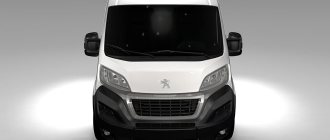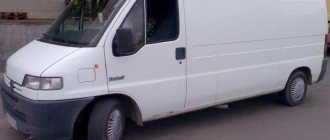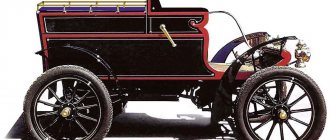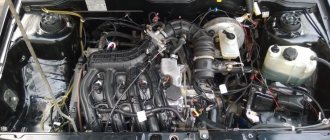The standard maintenance schedule for warranty Peugeot Boxers is 20,000 km. The oil volume in the system is 6, 6.3 or 7.3 liters - depending on the year of manufacture. To extend the life of the internal combustion engine in Russian conditions, it is advisable to reduce the oil change interval to 10,000–15,000 km. If the service interval is exceeded, clean the system of oil deposits and deposits using special flushing MF5. It effectively utilizes heavy metal oxides. In addition, it allows you to decarbonize the piston rings and restore their mobility. Due to the increased periodic maintenance interval, the oil loses its properties, it ages, which negatively affects the life of the oil pump, timing drive, turbine, and leads to increased chain noise and oil consumption.
The modern diesel engine of the P22DTE series is equipped with a Common Rail injection system. Due to low-quality diesel fuel, the injectors gradually become coked, mechanical wear occurs, a characteristic clicking sound appears, and the pressure regulator fails. Therefore, we advise you not to skimp on fuel and filters. Timely cleaning of injectors using DP3 allows you to remove carbon deposits without removing them, restore the spray pattern, restore pressure in the fuel line and extend the life of the pressure regulator on your Peugeot Boxer.
A catalytic converter is installed in the exhaust system for versions with a 2.2-liter engine. And Common Rail is controlled by a complex computer system. The cylinder head is based on high-strength cast iron. Additional strengthening was achieved thanks to heat treatment and the unique graphite surface structure. But this is not a panacea: overloads, cold starts, impurities in diesel fuel, and traffic jams lead to slow but sure wear of the working surfaces.
To increase the service life and protect the motor, tribological compounds RVS-Master are used. They form a durable metal-ceramic layer on the friction surfaces, which increases the pneumatic tightness of the cylinders, eliminates scuffing, restores oil pressure and reduces its consumption. The metal-ceramic layer significantly increases mileage - up to 120 thousand km.
For Peugeot Boxer with a P22DTE engine and an oil volume of 6 liters, the Di6 composition is used. RVS-Master, in combination with correctly selected 5w30 synthetics:
- Will restore compression.
- Reduces oil intake.
- Makes it easier to start at sub-zero temperatures.
- Stabilizes idle speed.
- Reduces noise and vibration.
- Protects friction surfaces from further wear and dry friction during a cold start.
Due to the design of the Peugeot Boxer transmission, bearings, shafts and gears are subject to high loads. To protect them, it is appropriate to use RVS-Master Tr3 or Tr5. The group of compounds is designed to eliminate noise and hum, and allow easy and smooth shifting of the gearshift lever. Repair and restoration compounds compensate for the wear of gears. The widely used BV5 MLUC boxes are designed to hold 2.1 liters of oil. Therefore, composition Tr3 is suitable for their in-place repair.
One of the main advantages of a Peugeot Boxer of any year is its light steering. But with a mileage of 200,000 km or more, the steering wheel may become tight, and a characteristic howl and hum of the power steering appears. To avoid the problem in normal operation, use Ps2, which eliminates wear and restores the nominal dimensions of parts.
Characteristics of Peugeot Boxer
The French company Peugeot has been producing Boxer vans since 1994. In 2002, the model was modernized: the front fascia was changed, including the radiator grille, bumper, headlights, new engines from the HDi line appeared, the number of body modifications was expanded to 50. The volume of HDi diesel engines is 2 liters, 2.2 liters or 2.8 l. The most powerful unit produces 128 horsepower. It is equally convenient for freight and passenger transportation.
Owners of the first generation Peugeot Boxer praise the front-wheel drive, high seating position, and solid engine life of the old turbocharged versions - up to 500,000 km. Most owners call the bus a “real workhorse.” Among the shortcomings are noted:
- Stiff suspension.
- Low quality plastic in the cabin.
- Less reliable versions released after 2000, as they are stuffed with electronics.
- A sharp increase in repair and maintenance costs with a mileage of 300–350 thousand km.
Mass production of the second generation Peugeot Boxer started in 2006. Until 2010, diesel engines with a volume of 2.2 or 3 liters were installed on cars. Later they were replaced by a modernized 2.2-liter engine and a powerful three-liter analogue. Maximum power increased to 177 horsepower. Paired with the new engines is a five- or six-speed MLGU manual transmission.
Interesting:
The assembly of the new Peugeot Boxer is carried out by Italian and French factories. An identical model, but called Manager, is produced in Mexico. In the Russian village of Rosva, the Peugeot Boxer has been assembled from imported components.
The carrying capacity of the new Boxer ranges between two tons. Thanks to the independent MacPherson spring suspension, the handling of the minibus is improved.
Italian specialists worked on the design and got rid of strict, straight lines. A U-shaped grille is integrated into the large front bumper, flanked by block headlights of the original design. To improve visibility, the glazing line was lowered and huge rear-view mirrors with turn signal repeaters were used.
| Advantages and disadvantages of the second generation Peugeot Boxer | |
| Low fuel consumption (popular 2.2-liter versions consume 7–8 liters per 100 km in the combined cycle; even minibuses designed for 18 people consume up to 10–11 liters per 100 km). | Weak ball joints and tie rod ends (the chassis is poorly adapted to our roads). |
| Decent dynamics ( The power of any version of the second generation Peugeot Boxer exceeds 100 hp. With. This is not so much, but thanks to the turbocharger there are no problems with overtaking). | Many people complain about doors rattling and creaking. . |
| Excellent handling (the bus is easy to drive, like any passenger car, especially for versions with air suspension; handling is better than that of its closest competitors - Mercedes Sprinter, Ford Transit, Volkswagen Crafter). | |
| Wide selection of body styles and engines (the volume of the body compartment ranges from 8 to 17 cubic meters; on the secondary market, the model is available with 2.2 and 3 liter diesel engines of various configurations, as well as a gasoline internal combustion engine). | |
Since 2015, restyled models have been produced with a number of positive changes: the body structure and aerodynamics have been improved, the range of available engines has been expanded, the suspension has been tuned in a new way, and the list of additional options has been expanded. Versions with a 2.2-liter 130-horsepower engine are already available in Russia. The official dealer is ready to offer Europeans a powerful 3.0 HDi diesel engine with 180 horsepower. All-wheel drive versions have been developed together with Dangel.
A little history about Peugeot
In 1976, competing companies - French automakers Citroen and Peugeot - merged into a single holding, PSA. Having entered into an agreement with the Italian Fiat, they combined capital, technology and design developments to conquer the market for commercial vehicles - light trucks for business. The three of them built one common plant to produce cars of this class. This company (“Sevel Sud” in the Italian city of Val di Sangro) has been producing light trucks with a gross weight of 2.5 to 3.5 tons and minibuses since 1981.
Peugeot J5
At the same time, each of the three automakers retains its own brand and model name. For Citroen it is Jumper , for Peugeot it is Boxer , for Fiat it is Ducato (the name of an old gold coin). The differences between these “twin brothers” are minimal, in terms of configuration, front and interior design. The third generation of “twins”, which went into production in 2006, most fully covered all niches of commercial use. In 2014, it was restyled.
“Three from the casket”: Jumper, Ducato, Boxer model 2006.
This is interesting: PAZ-4234 - technical characteristics of the bus
Repair and diagnostics of Peugeot Boxer
Peugeot Boxer
- one of the few taxi minibuses that has gained popularity in the commercial segment in the vastness of our country. This is the first such car with a transverse engine, front axle drive and single wheels on the rear axle. The enormous popularity of the Peugeot Boxer minibus is due to its comfort and high degree of safety (ABS + ESP airbags), as well as excellent dynamic characteristics thanks to the installed 2.2 HDi diesel engine with a power of up to 160 horsepower. The Peugeot Boxer is available in several body styles:
- a glazed minibus for transporting passengers, widespread in city taxis;
- all-metal van used for transporting goods;
- a chassis with a cabin that can be equipped with a cargo body with an awning or a booth with refrigeration equipment.
Each of the Peugeot Boxer variants has several modifications with different chassis lengths and body heights, door opening technology, and wheelbase types. Engines of the P220 family of 2.2 and 3.0 liters were developed by French manufacturers together with the American concern Ford Motors Company. In addition to the above-mentioned airbags and ABS, the minimum equipment for this brand of Peugeot Boxer minibus already contains ESP, power steering, an immobilizer and other modern technical solutions. Even the most powerful diesel engine and reliable suspension of the Peugeot Boxer sooner or later fail under the pressure of a load weighing more than a ton. The Peugeot Boxer utility vehicle, which is in constant use and transports furniture, office equipment or small wholesale products over long distances, requires timely service maintenance.
We repair Peugeot Boxer minibuses and vans in Moscow
The creators of the Peugeot Boxer really put a lot of effort into making a powerful, comfortable and reliable car. And since this car is a vehicle that is used a lot, it is logical to assume that the Peugeot Boxer repair
will be in demand. The 2.2HDI diesel engine is equipped with a turbine, the Peugeot Boxer is equipped with modern Common Rail fuel equipment, as well as the electronic fuel injection control system on this car model are complex devices; we are ready to eliminate all malfunctions that arise during the operation of the Peugeot Boxer with high quality, at reasonable prices and in as soon as possible. Our Diesel Service in Moscow is provided with all the necessary equipment and tools for the maintenance and repair of Peugeot Boxer with a diesel engine. Diesel Service "SARGAAS" offers you diagnostics, maintenance and routine repairs of your Peugeot Boxer at reasonable prices (additional discounts are available for corporate clients!). The specialists of our car service center in Moscow are ready to perform all necessary maintenance and repair work on the Peugeot Boxer with high quality, in the shortest possible time and with a subsequent guarantee. Also in our diesel technical center there is a department for the selection of Peugeot Boxer spare parts. We can offer you a choice of both original Peugeot Boxer spare parts and high-quality non-original parts at reasonable prices. When carrying out maintenance of a Peugeot Boxer in our service center on weekends, customers are given a 5% discount on spare parts and repair work performed on the Peugeot Boxer.
Recommendations for the regulations when carrying out maintenance of the Peugeot Boxer
Thanks to the accumulated experience in servicing Peugeot Boxer, we would like to give some recommendations to the owners of these cars.
- Undergo maintenance of Peugeot Boxer with a mileage of up to 10,000 km
- When carrying out maintenance, not only replace the engine oil, but also replace the fuel filter + air filter for the Peugeot Boxer
- Carry out diagnostics of the chassis during maintenance of the Peugeot Boxer (check each wheel bearing of the Peugeot Boxer for noise and play)
- Check the condition of the car's brake system, the brake fluid level (replace Peugeot Boxer brake fluid every 3 years, or with a mileage of 60,000 km), visually inspect the Peugeot Boxer brake discs and brake pads for wear
- Change the coolant at 60,000 km
- Replace timing belt on Peugeot Boxer with mileage up to 120,000 km
- Refuel with diesel fuel only at proven gas stations, to prevent premature failure of the injection pump and Peugeot Boxer injectors
- When undergoing maintenance and repairs of the Peugeot Boxer, use oils recommended by the manufacturer, as well as original Peugeot spare parts, or their high-quality substitutes
List of maintenance and repair work for Peugeot Boxer:
| Name of works | Cost of work |
| Replacement rear shock absorber 1 pc. | |
| Replacing the front shock absorber 1 pc. | |
| Coolant replacement | |
| Flushing the fuel tank | |
| Intake manifold Removal/Installation | |
| Replacing stabilizer bushings (removing the anti-roll bar) | |
| Remove the cylinder head / install the cylinder head | |
| Remove the generator (installation) | |
| Replacing the clutch master cylinder | |
| Replacing the muffler corrugation | |
| Removing the engine/Defecting the internal combustion engine/Assembling the internal combustion engine/Installing the internal combustion engine (new block) + washing of parts + repair of the cylinder head of the cylinder head | |
| Replace rear brake discs + replace brake pads (2 pcs.) | |
| Replace front brake discs + replace brake pads (2 pcs.) | |
| Replace brake discs + pads + replace hand brake pads (2 pcs.) | |
| Replace power steering fluid | |
| Replace brake fluid | |
| Measure the fuel pressure in the Common Rail fuel rail | |
| Measuring fuel pressure with injection pump | |
| Replace intercooler | |
| Replace catalyst (2 pcs.) | |
| Replace EGR valve | |
| Replace the fuel pressure control valve | |
| Replace rear brake pads | |
| Replace front brake pads | |
| Change the oil in the gearbox | |
| Replace the flywheel with the manual transmission removed | |
| Gearbox repair | |
| Replace the tie rod end | |
| Replace engine mount (right side) | |
| Replace left engine mount (standard version) | |
| Replace the upper radiator pipe | |
| Remove the front part of the engine compartment | |
| Replace the right drive shaft suspension bearing | |
| Replace the front wheel bearing | |
| Replace the wheel bearing | |
| Replace the cooling radiator | |
| Development of the gear shift mechanism Removal/Installation | |
| Flush the fuel rail | |
| Remove the steering rack (install) | |
| Replace alternator belt | |
| Replace the spring | |
| Replace sliding door roller (middle) | |
| Remove the front arm (install) | |
| Replace the front arm silent block | |
| Replace silent block springs (1 side) | |
| Replace glow plugs (1 pc.) (removing/installing the intake manifold, disassembling the front part of the engine compartment) | |
| Maintain the brake system (lubricate the caliper guides for 1 pc.) | |
| Remove starter (install) | |
| Replace the anti-roll bar strut | |
| Replace clutch kit | |
| Replace thermostat | |
| Replace the windshield wiper trapezoid | |
| Replace the rear parking brake cable (1 pc.) | |
| Replace the handbrake cable (central part) | |
| Replace the injector return pipe | |
| Replace the turbine | |
| Replace the air filter | |
| Change engine oil (oil filter) | |
| Replace the cabin filter | |
| Replace the fuel filter | |
| Adapt CR injector (Pilot injection injector kit) | |
| Remove common rail injector (install) | |
| Replace timing chain + replace oil pump chain | |
| Replace Timing Chain | |
| Replace the ball joint | |
| Replace the crankshaft pulley (w/w starter) | |
| Replace brake hose (front) | |
| Replace brake hose (rear) |
. If you don't like cats. You just don't know how to cook them.
Engine 2.2 hdi
Ford
and
PSA
center for the development and production of engines for commercial vehicles.
Diesel
2.2 hdi
engine is an analogue of the
Ford ZSD duratorq tdci
, in particular installed on Ford Transit cars.
We will look at this engine under the hood of the Peugeot Boxer and the third generation Citroen Jumper of the PSA Peugeot Citroën
.
The fuel equipment
2.2 hdi
diesel engine is a
common rail
designed by
denso
.
This fuel equipment allows you to achieve excellent performance in terms of power and torque, as well as engine noise and vibration. The engine is also equipped with an MHI Mitsubishi
with fixed charging geometry and an intercooler.
Features of this diesel engine
SWIRL
intake manifold system is worthy of attention, which, due to its design features, allows you to create turbulence in the intake air; the geometry of the air flow allows you to more efficiently mix air with fuel in the combustion chamber, which allows you to achieve smoother engine performance over a wide speed range.
PUMA diesel engine cylinder block
made of high-strength cast iron with a high-tech oriented graphite structure, which allows you to increase the service life of the cylinder mirror due to the oil retaining structure and increased strength of the cylinder wall.
The chain drive of the timing mechanism allows for more precise transmission of timing
; it is equipped with a double-row roller chain, generally has good reliability and reduced noise, as well as an increased service life compared to a timing
belt
.
The cylinder head of this engine, made of light alloy AS7 using a special thermomechanical processing technology patented by PSA,
.
The stated advantages of this cylinder head
speak of its increased resistance to overheating, and indeed the experience of repairing these engines confirms that when the engine overheats, the mating plane of the cylinder head is not subject to deformation as on other
cylinder heads
.
And in general, the cylinder head
of this engine has increased resistance to destruction
of cylinder head
and
timing
in the event of physical damage to the cylinder.
Our engine is 2.2hdi
has two modifications 100 and 120 l/s, the difference between these engines is the presence of a dual-mass flywheel and the presence of an additional cooling system for the piston bottom on the 120 l/s engine, the program in the engine control unit also differs.
According to our experience in repairing these engines, most often these engines encounter malfunctions associated with improper vehicle maintenance: failure to change oil and filters in a timely manner, poor quality fuel. In particular, there are cases of burnout of the piston bottom with further destruction of the piston due to a faulty nozzle. The reason for the malfunction of the injectors and other elements of the common rail
as with other engines, they arise due to unskilled and untimely maintenance of the engine fuel system, refueling with low-quality diesel fuel.
Overall diesel engine 2.2 hdi PUMA
is quite reliable, has the highest performance indicators, many high-tech solutions are used on this engine and the engine has proven itself well in our country due to the wide range of operating temperatures. In particular, our engine uses a modern cold start system for a diesel engine with intelligent control, which allows you to start the engine at temperatures below - 25 degrees in a short time with minimal loss of battery charge.
One of the new Peugeot Boxer owners spoke with delight about the advantages of his car, about its wonderful engine that “rips” everyone away from traffic lights and anxiously asked how long this diesel engine runs, how often does it break down and what diseases does it have? To answer these concerns I can here and now: the 2.2 hdi PUMA diesel engine
is a high-tech modern engine equipped with an excellent
common rail
, but the advantages of this engine have a price - the use of high-quality diesel fuel and timely qualified vehicle maintenance. If these two simple rules are followed, the engine practically does not break down and all engine components last their service life and even much more. So cooking these cats is not that difficult...
Ps We are often asked where the identification plates are on this car, we publish photos.
Here we will talk about the possibility of independently replacing the timing chain on a diesel Peugeot Boxer 2.2. Some people believe that it will not be possible to carry out repairs of this complexity on their own, but this is not so. Replacing a chain drive cannot be called a very complicated procedure, and every car enthusiast with little experience in repair work can cope with it.
Some car models use a belt as a transmission. It cannot be said that it is more efficient than a chain, although manufacturers increasingly prefer to install belt drives on their cars. The belt is made of rubber, which means that it can easily break. But this can happen at the most inopportune moment.
History of creation
First of all, it’s worth starting with the history of each of the engines under consideration. For example, it will be useful to find out the year the power unit was introduced, as well as the duration of its existence in the automotive market.
DW12TED4
This engine is practically the first in the DW12 family line. Its release took place in 1999, and during this time the engine has proven itself to be a reliable unit that satisfies the needs of many motorists.
The initial engine power at the time of release was 132 hp. It was installed on many ]Peugeot[/anchor] and Citroen cars.
The first changes took place in 2000. Manufacturers removed one of the two existing turbines from the DW12TED4, allowing the unit to be adapted for commercial use. Subsequently, the modernized engine was used on many models of vans and minibuses of French companies. Also, a couple of years later, the Fiat concern became interested in the engine, and decided to equip one of its cars with it.
Power unit DW12TED4 under the hood of a Peugeot 607.
In 2002, a car equipped with an engine of this model set a world record for the number of kilometers traveled in a year. Thanks to the amazing power and reliability of the unit, the car was able to cover a distance of 512 thousand km.
2006 marked the beginning of the expansion of the line of engines of the DW12 family. For example, manufacturers launched a motor such as the DW12BTED4. He was able to develop a little more power than his “big brother”, so little by little all subsequent members of the family began to displace the original model.
As for the DW12TED4 engine itself, throughout its entire existence it was a 16-valve diesel power unit manufactured by Peugeot. The volume of the unit was 2.2 liters, and its production was carried out from 2000 to 2006. Among the design features it should be noted:
- The presence of 4 cylinders in the block. In this case, cast iron without liners was used as a material for the manufacture of cylinders.
- The presence of 16 cylinder head valves, as well as two camshafts. The material for these structural elements is aluminum.
- Using a Common Rail fuel system.
- Built-in turbocharger that allows you to change the geometry. The engine design also included an intercooler.
- The presence of a timing belt, as well as a chain between the camshafts. It is worth noting that the use of belt drives has improved the reliability and quality of the engine and ensured its long-term performance.
- No need to adjust valves. For this, manufacturers used hydraulic compensators. They changed the position of the valves as soon as they sensed a change in pressure in the engine.
- Using a dual-mass flywheel.
Also in this engine model there is a system for changing air turbulence, which makes the operation of the car safer.
DW12BTED4
Also a member of the DW12 family. Its release took place from 2006 to 2010. The engine was a special unit installed only on prestigious cars of the French company. The engine capacity was 2.2 liters and the power reached 175 hp.
DW12BTED4
DW12C
Another motor from a number of DW12 engine models. The volume of this unit was 2.2 liters, production took place from 2010 to 2015. Basically, the engine was used only in two well-known models of the popular concern Peugeot, after which it ceased to be as in demand as at the beginning of its appearance on the automobile market. It is also worth noting that this engine is found not only on vehicles of French companies. The American automobile concern Ford equipped some of its models with the DW12C.
DW12C
DW12MTED4
The volume of this engine is 2.2 liters, and from the name it’s easy to guess which engine family it belongs to. The production and release of such a unit was carried out in the periods 2006-2010, and at that time manufacturers tried to install it only on clones of the Mitsubishi crossover. It is worth noting that this unit is almost identical in its characteristics to the DW12BTED4 model, and its main difference is the use of one turbine instead of two.
As for the features of this power plant, its main feature is that it is 4-stroke. Such motors have a more complex design. For example:
- The crankshaft is additionally equipped with a more massive flywheel, which ensures smooth movement of the pistons during engine operation.
- The cylinder block uses a gas distribution mechanism, mainly a belt one.
- The engine is started by using a starter inside the structure.
Finally, for the smooth operation of the DW12MTED4, manufacturers have used additional auxiliary devices, including various control systems, lubrication, fuel injection or cooling.
DW12MTED4
DW12UTED
We can say that this is the last member of the DW12 family that is worth mentioning. The engine capacity reaches 2.2 liters, and the power is 100-120 hp. depending on its modification. The production and release of the engine was carried out in the period 2002-2011. It was mainly used on popular minibuses of the Peugeot company of the same name, and also appeared on vehicles of the Citroen and Fiat concerns.
DW12UTED
When and why to change the chain?
The chains do not break (they very rarely do). But this does not mean that they will last forever. The chain also becomes unusable, although its service life is longer than the belt. What can happen to the chain, because it is made of high-quality metal? During operation, it may become damaged, resulting in chips or dents appearing on it. But the main problem with chain transmission is the possibility of its stretching. After some time, the pitch between the links increases and the chain stretches. If standard tensioning does not give a positive result, then the chain needs to be changed. Stretching the chain may result in it coming off the sprockets. And this is the same as a broken belt. As a result of the chain coming off, the synchronization of the movement of the shafts will be disrupted, the valves will collide with the pistons, which will lead to their deformation. Other parts of the mechanism will also suffer from this.
That is why it is so important to constantly monitor the condition of the chain drive and prevent it from stretching. Diagnostic procedures in this direction should be carried out at least every 25,000 km. And the service life of the chain itself varies from 150 to 200,000 km. But this does not mean at all that these regulations cannot be violated. How could he! Premature wear of the chain drive can be influenced by several factors, the main one of which is improper operation of the vehicle. What do you mean by improper use? First of all, this is an aggressive driving style. If you drive recklessly on the roads, then know that you should look under the hood of your car more often. If you use a car with a trailer, this also negatively affects the condition of the chain drive and may well cause it to stretch. Among other things, you simply could buy a low-quality consumable during the next replacement. Such chains do not last long. Experts recommend purchasing drives only from trusted stores. But if you buy it secondhand, then you just need to know how to check the chain for stretching. This is done as follows: place the chain flat on the palm of your hand. If it has sagged by more than 5 mm, there is no need to buy it; it is better to look for a quality consumable elsewhere.
So, if during the diagnostic procedures it was revealed that the chain was stretched and a decision was made to replace it, then start. First of all, you will need to prepare everything you need to carry out such repairs. Here we are talking about new consumables and necessary tools. For this you will need a standard tool:
- a set of keys;
- set of heads;
- jack;
- mount;
- pliers;
- screwdrivers with different blades.
Of the consumables, first of all you will need the chain itself. Be sure to buy a set of new gaskets and seals. Pay attention to the tensioner. If its condition is unsatisfactory, then it is better to buy a new one. This also applies to stars. You should not save on consumables for the timing belt. Ultimately, such savings will certainly result in additional expenses. And now, if everything is ready, then you can start.
Chain replacement steps
- First you need to de-energize the car by disconnecting the negative terminal from the battery.
- We get rid of the expansion barrel, because it will definitely interfere.
- Now the car needs to be raised using a jack. This is done in order to remove the right wheel.
- We dismantle the engine protection.
- After this you will need to remove the oil pump. Before reinstalling it, it will need to be cleaned of dirt. He probably had enough of it accumulated in him. The oil pump pipes will also need to be cleaned.
- We remove the power steering along with all its pipes and hoses.
- Now let's turn our attention to the generator. To remove it, you will have to unscrew several bolts securing it. We disconnect all wiring connected to it from the generator and take the wires to the side.
- Remove the water pump. When it is removed, the accelerator cable will be visible. It is supported on a bracket, which also needs to be dismantled.
- Remove the ventilation system pipe.
- The preparations are over. Now you can begin the main procedure - dismantling the chain drive. To do this, remove the motor housing. We remove the disc located on the crankshaft by unscrewing the bolt securing it. After this, we dismantle the roller disk.
- Now you can remove the tensioner. Let's check its condition. If you have to replace it, then you can simply throw away the old one. But if its condition is normal, we will not throw it away, but at the same time it will need to be cleaned of dirt and lubricated.
- After this, you need to remove the guide and tensioner lever.
- Remove the chain along with the camshaft gear. There are marks on the old chain that will need to be transferred to the new chain.
- We begin to install a new chain.
Specifications
Thanks to the technical characteristics, any interested car enthusiast will be able to learn as much as possible about the capabilities of the car and its engine when choosing the right vehicle for themselves. Therefore, it is worth listing the main characteristics of each motor model of the considered line of DW12 engines.
DW12TED4
All main characteristics are given in table form.
| Characteristic | Index |
| Cylinders, pcs. | 4 |
| Valves, pcs. | 16 |
| Engine volume, cm3 | 2179 |
| Cylinder diameter and piston stroke, mm | 85; 96 |
| Supply system | Common Rail |
| Maximum torque, Nm | 314 |
| Maximum power, hp | 133 |
| Type of fuel used | Diesel |
In addition to the characteristics, one should include an indicator of environmental standards, which corresponds to Euro 4/5.
DW12BTED4
The table also contains the characteristics of this engine.
| Characteristic | Index |
| Cylinder block material | Cast iron grade R4 |
| Block head material | 16v grade aluminum |
| Engine volume, cm3 | 2179 |
| Cylinder diameter and piston stroke, mm | 85; 96 |
| Supply system | Common Rail |
| Maximum torque, Nm | 370 |
| Maximum power, hp | 170 |
| Type of fuel used | Diesel |
| Availability of hydraulic compensators | Yes |
As for the environmental class, its indicator for this engine is EURO 4.
DW12C
The main characteristics of this power plant include those presented in the table below.
| Characteristic | Index |
| Cylinder block material | Cast iron grade R4 |
| Block head material | 16v grade aluminum |
| Engine volume, cm3 | 2179 |
| Cylinder diameter and piston stroke, mm | 85; 96 |
| Supply system | Common Rail |
| Maximum torque, Nm | 450 |
| Maximum power, hp | 204 |
| Type of fuel | Diesel |
| Availability of hydraulic compensators | Yes |
Ecological class EURO 5.
DW12MTED4
Among the technical characteristics of this motor are:
| Characteristic type | Index |
| Number of cylinders, pcs. | 4 |
| Number of valves, pcs. | 16 |
| Engine volume, cm3 | 2179 |
| Cylinder diameter and piston stroke, mm | 85; 96 |
| Supply system | Common Rail |
| Maximum power, hp | 72 |
| Type of fuel used | Diesel |
The model does not have increased power, but at the same time it is characterized by a fairly high-quality design.
DW12UTED
The characteristics are also summarized in the table.
| Characteristic type | Index |
| Cylinder block material | Cast iron grade R4 |
| Block head material | 16v grade aluminum |
| Engine volume, cm3 | 2198 |
| Cylinder diameter and piston stroke, mm | 86; 95 |
| Supply system | Common Rail |
| Maximum torque, Nm | 320 |
| Maximum power, hp | 120 |
| Type of fuel used | Diesel |
| Availability of hydraulic compensators | No |
Ecological class – EURO ¾.
As can be seen from the tables presented, the characteristics of the internal combustion engines under consideration are almost identical with the exception of several indicators. If we talk about the location of the engine number, then, due to the fact that each of the motors belongs to the DW12 line, the engine number has the same location: the area with the number is located to the right of the generator.
Main characteristics
Since 2006, Peugeot cars have been constantly improved, technical characteristics have been improved through the use of more economical devices, and, naturally, fuel consumption rates for the Peugeot Boxer have decreased. Today there are more than 50 variants of Peugeot bus models on the market, the latest of which have been brought to near perfection.
| Engine | Consumption (highway) | Consumption (city) | Consumption (mixed cycle) |
| L1H1 (diesel 6-mech, 2WD | 5.8 l/100 km | 8.5 l/100 km | 6.8 l/100 km |
| L2H2 (110 hp, diesel) 6-mech, 2WD | 6.4 l/100 km | 9.5 l/100 km | 7.5 l/100 km |
| L2H2 (130 hp, diesel) 6-mech, 2WD | 6.3 l/100 km | 9.2 l/100 km | 7.4 l/100 km |
| L3H2 (diesel) 6-mech, 2WD | 6.3 l/100 km | 9.2 l/100 km | 7.4 l/100 km |
| L3H2 Stop/Start (diesel) 6-mech, 2WD | 6.3 l/100 km | 8.6 l/100 km | 7.2 l/100 km |
| L4H2 (diesel) 6-mech, 2WD | 6.5 l/100 km | 9.3 l/100 km | 7.5 l/100 km |
Appearance, a harmonious combination of all characteristics, high functionality and efficiency explain the great popularity of Peugeot vans. Another plus is the real fuel consumption of the Peugeot Boxer - it is not so different from the official data as for cars of other brands and models.
Real fuel costs
As mentioned above, the fuel consumption and fuel consumption of the Peugeot Boxer are influenced by quite a few factors.
:
- driving style;
- driving mode;
- season;
- rubber;
- engine power;
- fuel quality;
- year of manufacture and total mileage;
- workload.
The first two points are of particular importance - they largely determine how much gasoline you will need per 100 km. If the driving style can be somehow changed, to give up speed and spectacular starts, then with driving cycles the situation is much more complicated. Whatever you do, the Peugeot Boxer will have significantly higher fuel consumption in the city than on the highway.
But you can also find a way out of this situation - moving at the same speed, a minimum number of stops, if possible, and consumption indicators will also decrease.
Considering that the dimensions of the Peugeot Boxer are not small, it is difficult to believe that according to official data, fuel consumption of the Peugeot Boxer per 100 km varies from 7 to 13 liters
. Of course, in reality these numbers are slightly higher, but due to the modernization of the latest models, the difference is not so great - this has been proven by many tests that the car passed before entering the domestic market.
Where were the engines installed?
During the production and release of all engines in this line of engines, each of them was installed on various car models of such well-known concerns as Peugeot, Citroen and Fiat.
DW12TED4
In the case of this unit, it was installed on the following vehicle models:
- Peugeot (406, 607, 807).
- Citroen (C5, C8).
- Fiat (Ulysse).
The engine was also installed on a 2002 Lancia Phedra. The unit was used as an internal combustion engine for two years.
DW12BTED4
This engine could be seen on the following models:
- Peugeot (406, 607, 807).
- Citroen (C5, C6, C8).
DW12C
As for this model, the engine was actively used in cars:
- Peugeot (508).
- Citroen (C5).
DW12MTED4
This type of unit was built into cars:
- Peugeot (4007).
- Citroen (C-Crosser).
Additionally, it is worth noting the use of the engine in the Mitsubishi Outlander model.
Data Comparison
One of the most pressing questions that drivers most often ask before purchasing is what is the fuel consumption of the Peugeot Boxer in the city, which is not surprising. Typically, such Peugeot vans are used for passenger or cargo transportation within the city, so more stops need to be made and the engine idles more often. This increases fuel consumption - for some models the mark can reach 15 liters according to official data.
The average fuel consumption of the Peugeot Boxer on the highway is slightly less, which is easily explained by the lack of frequent stops and downtime. Here the situation is the same as in the previous case - for some models 7 liters per 100 km is enough, and for some the consumption can exceed 12 liters. All this depends both on the Peugeot Boxer variation and on the factors listed above. If you are an experienced driver, it will not be difficult for you to achieve the minimum performance.
Gasoline consumption by the Peugeot Boxer in the combined driving cycle varies from 7 to 13 liters. The reasons remain the same: driving style, season, number of stops, general condition and car model. If you drive mainly on the highway, then the consumption will be lower, and accordingly vice versa.
The situation is a little better with a diesel engine: its consumption is much less, while the Peugeot Boxer picks up speed and works the same way as on gasoline. All technical characteristics, rules and recommendations regarding the economical use of diesel are the same as for gasoline. In addition, there are several options for diesel engines with different displacements, and you can easily choose the best option for you.
How to reduce fuel consumption
For some Peugeot Boxer models, fuel consumption still remains quite high, despite all the advantages and benefits of this bus. But don’t despair, there are general recommendations that will help you save
.
- You should stick to a calmer driving style and avoid sudden starts or braking.
- Try to make your Peugeot Boxer idle as little as possible.
- During the cold season, leave your car in warmer rooms. Due to this, it will take you less time and, accordingly, less fuel to warm up the engine.
- Refuel only with high-quality fuel. Its consumption lasts longer and it does not have a detrimental effect on internal parts.
- Keep an eye on the general condition of your Peugeot Boxer: the presence of any even minor breakdowns requires more fuel consumption.
- Do not forget to change summer tires to winter ones, and vice versa.
- You can upgrade some parts, including the fuel tank; today this can be easily done at any service center. This will also help to slightly reduce fuel consumption on the Peugeot Boxer.
- Promptly undergo technical inspections at a service station and replace outdated or worn parts.
By following these simple tips and reviews from owners, you can significantly reduce gasoline or diesel consumption. By the way, it was the Peugeot Boxer that set a record in terms of fuel economy - with skillful driving and following all the rules, you can spend only 6.9 liters per 100 km.
Car device
The Peugeot Boxer model is designed and manufactured taking into account various factors. The design virtually eliminates the accumulation of dust and dirt in hard-to-reach places. Almost 2/3 of the structural material is galvanized steel. External surfaces are subjected to double galvanic coating and 5 layers of a special protective composition. This approach reliably protects the truck from corrosion.
Peugeot Boxer body cladding Steel sheets up to 1.8 mm thick are used as body cladding material for the Peugeot Boxer. This is enough to withstand various road impacts and mechanical shocks. In addition, the chassis with increased rigidity gives additional strength to the automotive structure.
The front suspension of the Peugeot Boxer is well adjusted. It, together with the power steering, guarantees high maneuverability and ease of vehicle control in general. Even in the original configuration of the Boxer, a modern anti-lock braking system is provided, and the model can be further equipped with an ASR slip control system, an overtaking sensor, a rear view camera, ultrasonic detectors and parking sensors.
Body types
The car is available in the following body types:
- van;
- chassis;
- cargo-passenger;
- minibus.
Van. Common body design. It is used for transporting equipment, food, furniture and other goods, as well as for transporting people. Van-type vehicles are excellent for working in emergency services (ambulance, rescue services). Peugeot Boxer ambulances
Chassis. Universal body type. A high load capacity of up to 1900 kg and the ability to mount special equipment on the frame allow you to perform various tasks on vehicles with a chassis body. They are used as a tow truck and flatbed platform. They are often modified into refrigerators, insulated vans, dump trucks, and tanks.
Cargo-passenger. This body combines the advantages of a cargo van and a minibus. Peugeot Boxer Combi cars are an excellent alternative to a minivan, only with more space. The combined model can accommodate up to 9 passenger seats with various options for their location. Branded seats are covered with high-quality finishing and come in two types: soft and hard. Especially for this model, quick-release type fastenings are provided.
Minibus. A body option for passenger transportation with a high level of comfort, which allows you to change the interior configuration. The Peugeot Boxer Tour Transformer model is equipped with folding sofas that can be moved to free up space for other needs. As a result of such manipulations, the interior of the minibus can easily be transformed into a mobile office for negotiations, a room for an overnight stay and a cargo van.
Driver's seat equipment
The driver's seat, unlike the passenger seat, is equipped with many adjustments, which allows you to drive the vehicle with ease. Initially, the model is equipped with external electrically adjustable and electrically heated mirrors. Each mirror consists of 2 elements (one spherical) - this reduces “dead zones” and gives a feeling of complete control of the situation. The high seating position and large windows provide good visibility for the driver.
Bottom line
Fuel consumption on a Peugeot Boxer is one of the most pressing issues that worries drivers. As you can see, it can be reduced to a minimum if you have patience and rely on the experience of other owners. Elegant appearance, high functionality and productivity, constant improvement are the main advantages of the Peugeot Boxer, which overshadow all minor shortcomings. Moreover, manufacturers are releasing more and more new models and parts for old ones, which can significantly reduce the fuel consumption of the Peugeot Boxer per 100 km.










